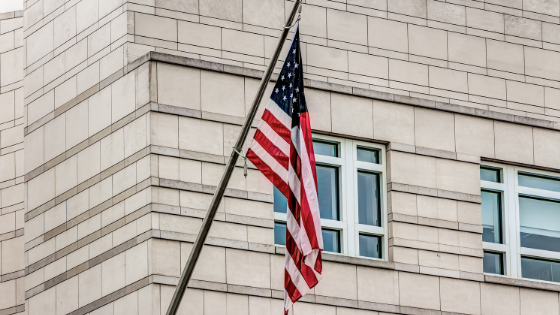Editor’s note: Trade Ambassador Bob Lighthizer stands strong against the globalists who have killed jobs for many years.
At an invitation-only gathering of chief executives in mid-September, Robert E. Lighthizer made his pitch for President Trump’s protectionist trade policy.
[David Lynch | November 15, 2019 | Washington Post]
Seated between United Parcel Service CEO David Abney and Boeing chief Dennis Muilenburg, Lighthizer, the chief U.S. trade negotiator, argued that attempts to integrate China into the global economy have failed American workers. Trump’s bare-knuckled alternative is warranted, he said, even if it costs the economy in the short term.
Attendees at the Yale School of Management conference — held beneath an open-air, rooftop tent with views of the U.S. Capitol building — weren’t convinced. In a snap poll, 80 percent complained that “business confidence is suffering as a result of U.S. trade policy.”
The president’s embrace of tariffs, which the Federal Reserve says is sapping business investment and economic growth, was the executives’ biggest gripe.
“He’s under enormous pressure from the Wall Street faction,” said Stephen K. Bannon, the former White House chief strategist. “Lighthizer hasn’t lost any of the toughness. He has an open door to hear complaints, and he’s hearing a lot of them.”
As Trump approaches his third anniversary in the White House, Lighthizer is one of only a few senior officials to retain both the president’s confidence and his professional reputation.
Much is at stake. White House National Economic Council Director Larry Kudlow said late Thursday that a deal with China could be close and that upbeat sentiment led the stock market to close at record levels on Friday.
Trump and Lighthizer say foreign countries for decades have taken advantage of Washington’s inattentiveness to rip off the United States. By confronting U.S. trading partners on multiple continents, they promise to rebalance global commerce in favor of American workers.
Like a more polished version of his freewheeling boss, Lighthizer has busted precedent, bent rules and left a trail of discomfited traditionalists in his wake. No constituency has been more unsettled than corporate America.
Now Lighthizer and the business community are awkward partners in a rush to seal two major prizes: a North American trade accord, which awaits lawmakers’ approval, and an unfinished deal with China.
In September alone, Lighthizer met or spoke by phone with the leaders of Apple, General Motors, Cisco, Dow, UPS, Boeing, Honeywell and Arcelor Mittal, as well as representatives from the U.S. Chamber of Commerce, the National Association of Manufacturers and the Business Roundtable, according to his office calendar on the U.S. Trade Representative (USTR) website.
But the stepped-up engagement has produced only an uneasy truce, with business groups remaining deeply skeptical of Lighthizer’s tariff-heavy strategy. “There are still points of friction,” said Rufus Yerxa, president of the National Foreign Trade Council. “There are still major, major concerns about the direction of Trump’s trade policy.”
Lighthizer’s aides, as is their custom, did not respond to a request for comment.
Those doubts date to Lighthizer’s first months in office. In September 2017, he joined several prominent chief executives in a conference room near Capitol Hill for what should have been a friendly get-together.
Lighthizer was a former Senate Republican aide, a veteran of the Reagan administration and a well-heeled corporate lawyer. His audience included the heads of corporations such as Walmart, Bank of America and AT&T, men and women who were pillars of the economy and of the Republican Party.
But on this day, Lighthizer sounded more like an adversary than an ally, dismissing the CEOs’ objections to Trump’s protectionism as the pleading of “special interests.”
The verbal clash with the Business Roundtable’s board of directors wasn’t an isolated event. Weeks later, at another private session with corporate chieftains, Lighthizer’s indifference to concerns about the probable costs of the president’s plan to confront China left members of the U.S.-China Business Council similarly dismayed.
Lighthizer has been received more warmly on Capitol Hill, where his opposition to the traditional “free trade” gospel overlaps with liberal Democrats’ globalization critique. The administration has been pushing House Speaker Nancy Pelosi (D-Calif.) to schedule a vote on the U.S.-Mexico-Canada agreement (USMCA). But with about 15 legislative days remaining in 2019, the deal risks slipping into a prolonged election-year limbo.
The emerging China deal, meanwhile, appears likely to fall short of Lighthizer’s stated goal: to compel China to make structural changes in its economy that will prevent it from supplanting the United States as the global technology leader. Amid signs of a modest initial harvest, the trade chief is resisting demands from the Chinese — and U.S. corporations — to scrap tariffs on $112 billion in consumer goods that took effect Sept. 1.
“Our economic relationship with China has been unbalanced and grossly unfair to American workers, farmers, ranchers and businesses for decades,” Lighthizer told the Senate Finance Committee in June. “After an exhaustive process, we put tariffs on certain Chinese products and are preparing to do more if certain issues cannot be resolved satisfactorily.”
Tariffs are the core of Lighthizer’s negotiating strategy. But they represent a costly complication for many American businesses.
Jasco, an Oklahoma City-based maker of lighting, home security, cables and power products, has been hit by each of Trump’s four rounds of China tariffs. The levies on Chinese imports have raised the 400-worker company’s annual costs by up to $50 million and erased its profits, according to chief executive Jason Trice.
He’s won some tariff exclusions and passed along price increases to customers, which include General Electric and Honeywell. But more than 18 months into Trump’s trade war, the cloudy outlook for Lighthizer’s talks with China — which might involve the elimination of some, all or none of the existing tariffs — complicates Trice’s planning.
“Any competent businessman knows you need certainty and predictability. This is the antithesis of that,” he said. “A deal without the removal of the tariffs doesn’t do us any good.”
Other trade war victims are petitioning the government for a taxpayer bailout. The administration already is paying $28 billion to farmers who have lost export sales because of China’s retaliatory tariffs. The Hardwood Federation recently submitted a proposal to the Agriculture Department, seeking financial aid to offset annual industry losses estimated at $651 million.
Some of the nation’s sawmills “are concerned they’re not going to survive,” said Dana Cole, the federation’s executive director.
Lighthizer, 72, grew up in Ashtabula, a Great Lakes port in northeast Ohio, which suffered with the steel industry’s decline. The son of a doctor, he was educated in a Catholic school and read Gentlemen’s Quarterly as a teenager.
His hometown’s steady deterioration, however, coupled with his legal work on behalf of steel companies seeking protection from foreign rivals, forged protectionist views that were at odds with the era’s bipartisan consensus on trade.
“For 30 years, he was a voice in the wilderness,” said his older brother James, president of the Civil War Trust. “He’s emphatic about it. He really believes we’ve given away the store.”
The wilderness years ended with Trump’s 2016 triumph. A partner at Skadden, Arps, Slate, Meagher & Flom, Lighthizer had been anticipating retiring to his oceanfront Palm Beach, Fla., condo, about three miles north of Trump’s Mar-a-Lago, before the president-elect called.
Bannon, who said he helped bring Lighthizer to Trump’s attention, likened the trade chief’s relationship to the president to that between a board chairman and a corporate attorney. The president provides the vision — and serves as chief public spokesman — for the administration’s trade policy. And Lighthizer figures out how to make it work, using his detailed knowledge of U.S. trade law.
“He never speaks unless he absolutely knows everything about the topic,” Bannon said. “Trump gravitates to that. He likes him personally and admires him as a professional.”
Lighthizer has also made allies of other powerful White House figures, including Trump’s son-in-law Jared Kushner, who was instrumental in the negotiations to rewrite the North American Free Trade Agreement, and congressional Democrats.
Lighthizer has been careful to avoid the spotlight, seldom speaking to reporters and allowing Trump to play the starring role in the trade war.
“Lighthizer does care a lot more about managing his relationships inside the government than he does outside,” said one former senior USTR official, who spoke on the condition of anonymity to talk candidly. “And I can’t say he’s made a miscalculation on that in this administration because so many policies have foundered on poor internal coordination.”
The USTR has avoided the State Department’s cratering morale and the Commerce Department’s chronic dysfunction. He relies on a core group of loyalists, including many veterans of Skadden, where he once directed the trade practice, to run the agency. Having once been a young lawyer at USTR, he values the contributions of career professionals.
His portfolio carries make-or-break implications for the president’s political fortunes. Trump took office vowing to rebalance trade to benefit what he called the forgotten men and women of the industrial heartland.
Factories added 484,000 jobs on Trump’s watch, but manufacturing employment peaked two months ago and has been shrinking in key states such as Wisconsin, Pennsylvania and Michigan.
Pat Buchanan, whose 1992 Republican primary campaign anticipated many of Trump’s economic and cultural themes, applauded Lighthizer’s efforts.
“Amb. Lighthizer is first-rate, the best man in memory in his post, and one of the few who understands economic nationalism, and that trade is about more, much more, than pure economics,” Buchanan said in an email. “Not until Trump and Lighthizer did we have a US team so dedicated to the proposition of America First. But, is it a hard thing to turn the ship around after decades of ‘free-trade’ inter-dependency.”

Indeed, while Lighthizer’s charm offensive on Capitol Hill has won Democrats’ plaudits, Pelosi has yet to schedule a vote on the USMCA’s implementing legislation. And Lighthizer is said to be growing frustrated with some Democrats’ demands for additional concessions on protecting labor rights under the agreement.
Likewise, on the China talks, after coming close to a deal in early May, negotiators have treaded water. While enjoying a cordial relationship with the top Chinese negotiator, Vice Premier Liu He, Lighthizer is profoundly skeptical of the Chinese government’s willingness to comply with any agreement. His repeat visits to Beijing also have left him unimpressed. “I don’t know how you live here,” he once told a China-based American diplomat.
The president last month announced an “agreement in principle” on a limited deal, which is intended to be only the first in a multistep process. But even securing this deal has proved elusive, and Chinese officials have not publicly confirmed the benefits that Trump claims he has secured for farmers.
“He sees his life and work to limit the damage China has done to the global trading system and U.S. economy,” said one Lighthizer associate, who spoke on the condition of anonymity to speak frankly. “It would be an incredible lost opportunity after a year and a half of drama and Peking Opera, if all we get are some soybean purchases.”
Bannon calls Lighthizer “an American hero” and likens him to the late actor Jimmy Stewart. But on each of the seven Chinese trade practices that the administration has said must be curtailed, “China’s doing more today than when we got in,” Bannon said.
Read the original article here.












